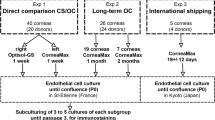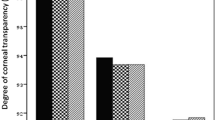Abstract
Introduction
To elucidate the specific functions of the primary cilia in corneal endothelial cells (CECs) by investigating the histological changes of corneal endothelium exposed at low temperature.
Study design
Experimental study.
Methods
This study involved corneas freshly obtained from Japanese white rabbits preserved in Optisol™-GS (Bausch & Lomb) corneal storage medium at 4 °C for 0, 1, and 7 days. Corneas preserved for 7 days were also incubated at 37 °C in culture media for an additional 2 days. A rabbit CEC line was also preserved in Optisol™-GS at 4 °C for 0 and 1 day. The corneal endothelium specimens and CECs were then assessed by immunostaining and scanning electron-microscopy (SEM).
Results
Immediately post isolation, the CECs of the specimens showed positive immunostaining for primary cilia (i.e., approximately 20%) via anti-acetylated alpha Tubulin antibody and SEM observation. Primary cilia were found to have attenuated/disappeared on the corneal endothelium specimens preserved for 1 or 7 days at 4 °C. After an additional 2-day incubation at 37 °C, primary cilia reappeared on the corneal endothelium specimens (approximately 20%). The disappearance of cilia during the preservation period was also observed in the immortalized CECs.
Conclusion
The findings in this study using rabbit corneas indicate that the primary cilia of corneal endothelium preserved at low temperature disappeared, then reappeared after returning to body temperature, suggesting that temperature has a direct effect on the primary cilia of corneal endothelium.



Similar content being viewed by others
References
Zimmermann KW. Beiträge zur Kenntnis einiger Drüsen und Epithelien. Arch Mikr Anat. 1898;52:552–706 (in German).
Praetorius HA, Spring KR. Bending the MDCK cell primary cilium increases intracellular calcium. J Membr Biol. 2001;184:71–9.
Nauli SM, Alenghat FJ, Luo Y, Williams E, Vassilev P, Li X, et al. Polycystins 1 and 2 mediate mechanosensation in the primary cilium of kidney cells. Nat Genet. 2003;33:129–37.
Yeh C, Li A, Chuang JZ, Saito M, Cáceres A, Sung CH. IGF-1 activates a cilium-localized noncanonical Gβγ signaling pathway that regulates cell-cycle progression. Dev Cell. 2013;26:358–68.
Nonaka S, Tanaka Y, Okada Y, Takeda S, Harada A, Kanai Y, et al. Randomization of left-right asymmetry due to loss of nodal cilia generating leftward flow of extraembryonic fluid in mice lacking KIF3B motor protein. Cell. 1998;95:829–37.
Klyce SD, Beuerman RW. Structure and function of the cornea. In: Kaufman HE, Barron BA, McDonald MB, Waltman SR, editors. The cornea. New York: Churchill Livingstone; 1988. p. 3–54.
Gallagher BC. Primary cilia of the corneal endothelium. Am J Anat. 1980;159:475–84.
Blitzer AL, Panagis L, Gusella GL, Danias J, Mlodzik M, Iomini C. Primary cilia dynamics instruct tissue patterning and repair of corneal endothelium. Proc Natl Acad Sci USA. 2011;108:2819–24.
Hosoi K, Ikuse T, Okazaki T, Tanioka H, Takase K, Suda H. A 13-week safety evaluation of pirenoxine ophthalmic suspension (Kary Uni) in rabbits. Atarashii Ganka (J Eye). 1993;10:1399–403 (in Japanese).
Armitage WJ, Easty DL. Factors influencing the suitability of organ-cultured corneas for transplantation. Investig Ophthalmol Vis Sci. 1997;38:16–24.
Koizumi N, Sakamoto Y, Okumura N, Okahara N, Tsuchiya H, Torii R, et al. Cultivated corneal endothelial cell sheet transplantation in a primate model. Investig Ophthalmol Vis Sci. 2007;48:4519–26.
Pels E, Rijneveld WJ. Organ culture preservation for corneal tissue. Technical and quality aspects. Dev Ophthalmol. 2009;43:31–46.
Jeng BH. Preserving the cornea: corneal storage media. Curr Opin Ophthalmol. 2006;17:332–7.
Kitazawa K, Inatomi T, Tanioka H, Kawasaki S, Nakagawa H, Hieda O, et al. The existence of dead cells in donor corneal endothelium preserved with storage media. Br J Ophthalmol. 2017;101:1725–30.
Acknowledgements
The authors wish to thank John Bush for reviewing the manuscript and Hideto Deguchi, MD for conducting additional experiments on the 34 °C organ culture. This work was supported by Grants-in-Aid for Scientific Research from the Japan Society for the Promotion of Science (JSPS) (Grant No. JP90171834 and No. JP20K09832).
Author information
Authors and Affiliations
Corresponding author
Ethics declarations
Conflicts of interest
H. Tanioka, Employee (Santen); K. Shinomiya, Employee (Santen); S. Kinoshita, None; C. Sotozono, None.
Additional information
Publisher's Note
Springer Nature remains neutral with regard to jurisdictional claims in published maps and institutional affiliations.
Corresponding Author: Hidetoshi Tanioka
Supplementary Information
Below is the link to the electronic supplementary material.
10384_2022_933_MOESM2_ESM.pptx
Supplemental Figure 2 The primary cilia of rabbit corneal endothelium preserved in organ culture media at 34 °C. a The corneal endothelium immediately after 7-day preservation in organ culture media. Endothelium showed anti-acetylated alpha Tubulin-positive primary cilia. b Arrows indicate the primary cilia at a. The fluorescein-stained specimens were inspected via the use of a confocal laser microscope (FV1200IX83; OLYMPUS, Tokyo, Japan), and confocal laser-scanning microscopy images were captured. Scale Bar = 50 μm (PPTX 729 KB)
About this article
Cite this article
Tanioka, H., Shinomiya, K., Kinoshita, S. et al. Temperature effects on the disappearance and reappearance of corneal-endothelium primary cilia. Jpn J Ophthalmol 66, 481–486 (2022). https://doi.org/10.1007/s10384-022-00933-0
Received:
Accepted:
Published:
Issue Date:
DOI: https://doi.org/10.1007/s10384-022-00933-0




